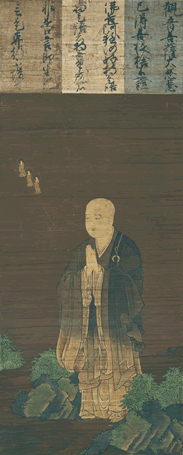
Back Shandao French Shandao ID 善導 Japanese Shandao Polish Шаньдао Russian Shan-tao Swedish Thiện Đạo Vietnamese 善导 Chinese
Shandao | |
|---|---|
善導 | |
 Shandao, Muromachi period, Ōtani University Museum. | |
| Personal life | |
| Born | 613 |
| Died | 681 (aged 67–68) |
| Nationality | Chinese |
| Notable work(s) | Commentary on the Contemplation Sutra |
| Religious life | |
| Religion | Buddhism |
| Temple | Wuzhen Temple Xuanzhong Temple Wenguo Temple Fengxian Temple |
| School | Pure Land Buddhism |
| Dharma names | Shandao |
| Senior posting | |
| Teacher | Mingsheng (明勝) Daochuo |
Students
| |
Shandao (simplified Chinese: 善导大师; traditional Chinese: 善導大師; pinyin: shàndǎo dàshī; Japanese: Zendō Daishi; 613–681) was a Chinese Buddhist scholar monk and an influential figure of East Asian Pure Land Buddhism.[1][2]
Shandao was one of the first Pure Land authors to argue that all ordinary people can be reborn in the Pure Land by relying on the karmic power of Amitābha Buddha's past vows.[1] Shandao was also one of the earliest Pure Land authors to teach the primacy of faithfully reciting Amitābha's name (nianfo), seeing this practice as sufficient for birth in the Pure Land.[3][4] This, along with Shandao's efforts in disseminating paintings of the Pure Land, made Pure Land Buddhism much more accessible and popular among the common people.[5]
Several modern scholars consider Shandao to be the true founder of the Chinese Pure Land tradition.[1][3] According to Alfred Bloom, Shandao "systematized Pure Land thought and brought it to its highest peak of development in China."[3]
Shandao's writings had a strong influence on later Pure Land masters, especially his focus on the vocal recitation of the name of Amitābha.[6] He is also very important for Japanese pure land founders Hōnen and Shinran. In Jōdo Shinshū, he is considered the Fifth Patriarch, while in Chinese Pure Land Buddhism, he is considered the second patriarch after Lushan Huiyuan.
- ^ a b c Jones (2019), pp. 20-21
- ^ "Pure land Buddhism".
- ^ a b c Cheung, Tak-ching Neky. and 張德貞. “A comparative study of the pure land teachings of Shandao (613-681) and Shinran (1173-1262).” (2001).
- ^ Cite error: The named reference
:2was invoked but never defined (see the help page). - ^ Atone 1988, p. 144.
- ^ Atone 1988, p. 133.